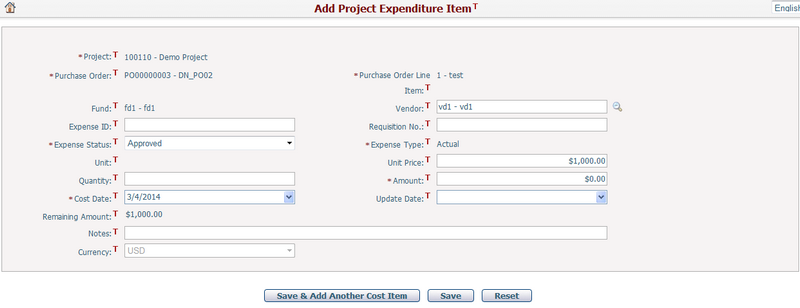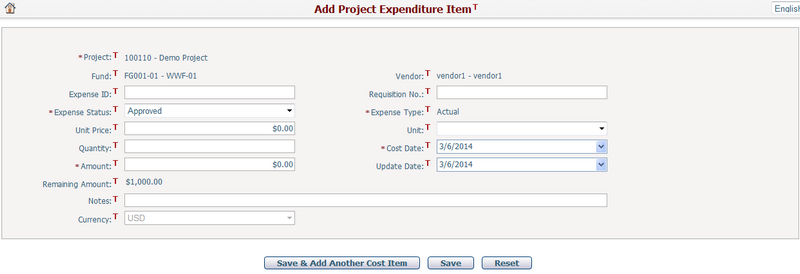Navigate Here: Financials > Expenses > Add Project Expense
The Add Project Expenditure Item page is for recording project expenses.

There are three expense types: Actual, Encumbrance, and Pending.
Actual Expense means the expenditures are actually paid out. An actual expense can be manually added, or from partial payments against an encumbrance or pending expense.
Encumbrance Expense means the expenditures are expected to be paid. An encumbrance expense can be automatically added from a Contract/PO line item when the line item is approved, or manually added by the user. System will allow partial payment against an encumbrance expense.
Pending Expense is similar to Encumbrance. It means the expenditures are expended and will be paid in the future but do not go through a Contract/PO. A pending expense can only be manually added. System will allow partial payment against a pending expense.
To add a project expense, provide the general information by filling in the following fields:
The required fields are noted with an asterisk (*).
Project*: Specify the project which the expense belongs to. Browse and select a project by clicking ![]()
Fund: Select a fund source where the project expenditure item comes from. Browse and select a fund by clicking ![]()
Vendor: Select a vendor by clicking ![]() . If a vendor is not in the list, you can add it in Add Vendor.
. If a vendor is not in the list, you can add it in Add Vendor.
Expense ID: The ID of the project expense. It must be unique.
Requisition No.: The requisition number of the project expenditure item.
Expense Status*: There are three project expense statuses: On-Hold, Approved, and Rejected. Only the Approved expense will be calculated as the real expenditure.
Expense Type*: Select a type from list of Actual, Encumbrance and Pending. See the explanations above.
Unit: The unit for the number of items that will be expended.
Unit Price/Quantity/Amount*: The quantity and unit price of the items. The Amount shows the calculated total expense or the expense directly input by the user.
Cost Date*: Specify the date when incurring the expense.
Update Date: Specify the date when updating the expense.
Notes: Description of the expense.
Currency: Select the currency of the expense by the currency code dropdown list. Its default value is the default currency of the current user. But when creating expense against a specified source line item (e.g. contract line item or PO line item), it will automatically change to the currency of that source line item.
Add Encumbrance/Pending/Actual Expense (Non-Contract/PO Related)
If you enter this page from the Add Project Expense menu, that means you will add an non-contract/PO expense.
Associated Budget Line Item*: Manually enter the expense fields such as Project, Fund, and custom fields, or simply load these values from a budget line item. You may click the Load From Budget button to search and select the related budget line items on a pop up window. Select a budget line item and click OK, and the budget line item information will be loaded on the Add Project Expense page accordingly.
Expense Status will be Approved by default but can be edited. Only approved payments will be counted as valid expenditures.
Expense Type: Select the expense type you want.
Budget Checking can be Enabled or Disabled by configuration.
❖ If Budget Checking is Enabled, this expense needs to be matched with budget.
Under this configuration, when you click on the Save button, the system will check whether there is a budget line item which has the same values for the common attributes (Fiscal year + Project ID + Fund ID + Currency Code + other financial structure attributes configured by the user) in its structures as those in the expense. Budget line items with a fiscal year that is not the same year as the cost date of the expense will not be matched.
If the matching budget line item exists, the system will link this budget line item to the expense regardless of whether the values of the expense attributes are loaded from budget or manually entered by the user. Budget Balance of the matching budget line item will be recalculated accordingly. Error message will be shown when budget is overspent.
If no matching budget line item exists, error message same as budget overspending will be shown.
❖ If Budget Checking is Disabled, expense does not need to match with budget.
Add Partial Payment for Contract

If you enter into this page by clicking the Payment link on the Manage Contract Line Items page, or clicking the Record Payment link on the Modify Project Expense page of a contract related encumbrance expense, it means that you will add contract actual expense for partial payment.
Associated Contract Line Item*: Project, Contract, Contract Line Item, Fund, Vendor and custom fields will be loaded from the specified contract line item.
Expense Status will be Approved by default but can be edited. Only approved payments will be counted as actual expenditures.
Expense Type: It is Actual and cannot be edited.
Remaining Amount: The remaining amount that has not been actually paid of the specified contract line item, it is automatically calculated by system and cannot be edited.

If you enter into this page by clicking the Payment link on the Purchase Order Line Items page, or clicking the Record Payment link on the Modify Project Expense page of a PO related encumbrance expense, it means that you will add PO actual expense for partial payment.
Associated PO Line Item*: Project, PO, PO Line Item, Fund, Vendor and custom fields will be loaded from the specified PO line item.
Expense Status will be Approved by default but can be edited. Only approved payments will be counted as actual expenditures.
Expense Type: It is Actual and cannot be edited.
Remaining Amount: The remaining amount that has not been actually paid of the specified PO line item, it is automatically calculated by system and cannot be edited.
Add Partial Payment for Encumbrance/Pending Expense

If you enter into this page by clicking the Record Payment link on the Modify Project Expense page of a non-contract/PO related encumbrance or pending expense, it means that you will add non-contract/PO actual expense for partial payment.
Associated Expense Item*: Project, Fund, Vendor and custom fields will be loaded from the specified expense item.
Expense Status will be Approved by default but can be edited. Only approved payments will be counted as actual expenditures.
Expense Type: It is Actual and cannot be edited.
Remaining Amount: The remaining amount that has not been actually paid of the specified encumbrance/pending expense item, it is automatically calculated by system and cannot be edited.
Click the Save & Add Another Cost Item button to save the data. The system will return to the Add Project Expense page, where you can add another expense.
Click the Save button to save the data. The system will then go to the Modify Project Expense page which displays the encumbrance/pending expense item that contains the current payment information.
Note: When an Actual Expense is saved as a partial payment, a corresponding Encumbrance/Pending Offset will be automatically created, which has the same information as the actual expense except that its Unit Price and Quantity is zero, its Amount is the negative value of the actual expense amount and its Remaining Amount is N/A.